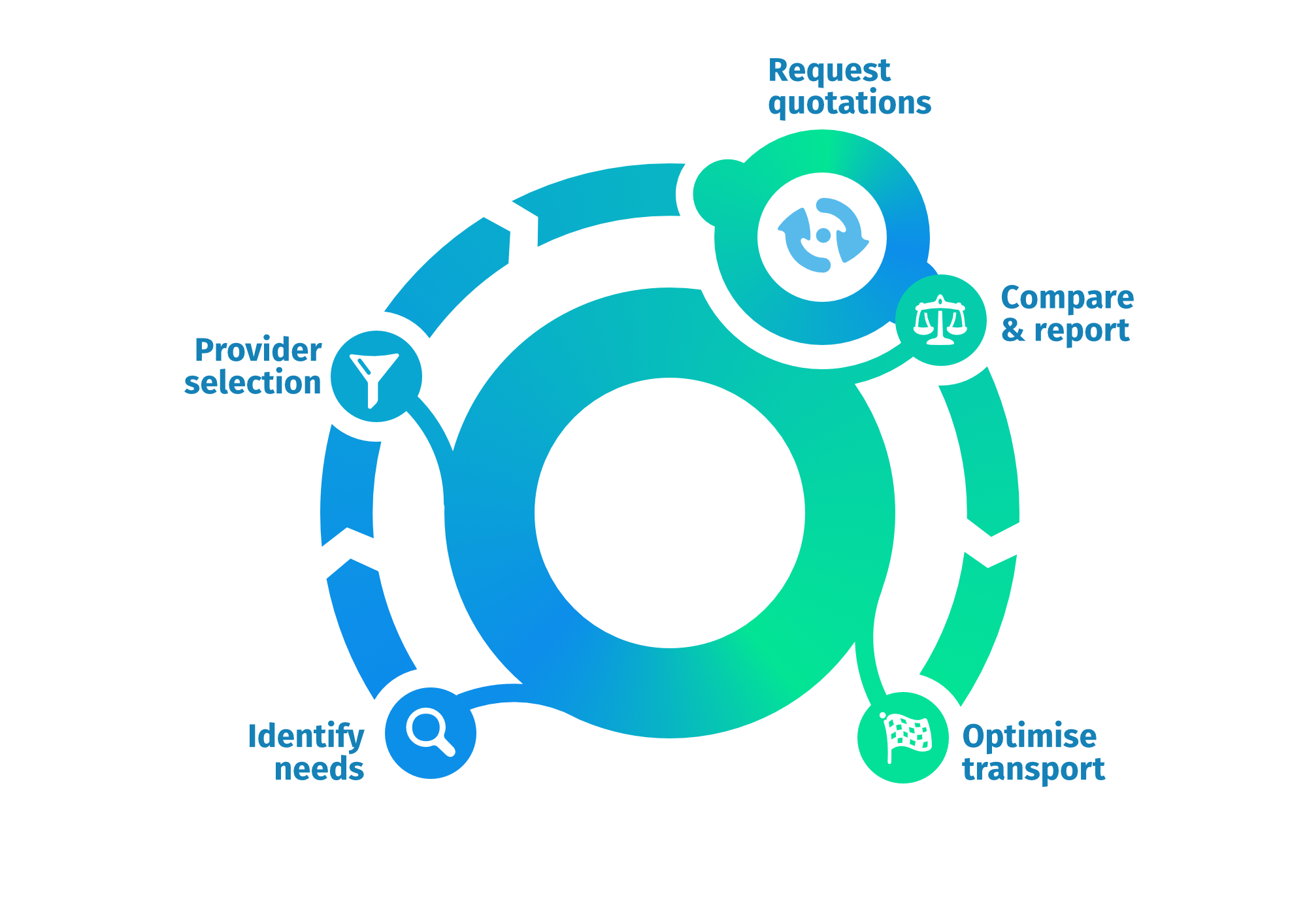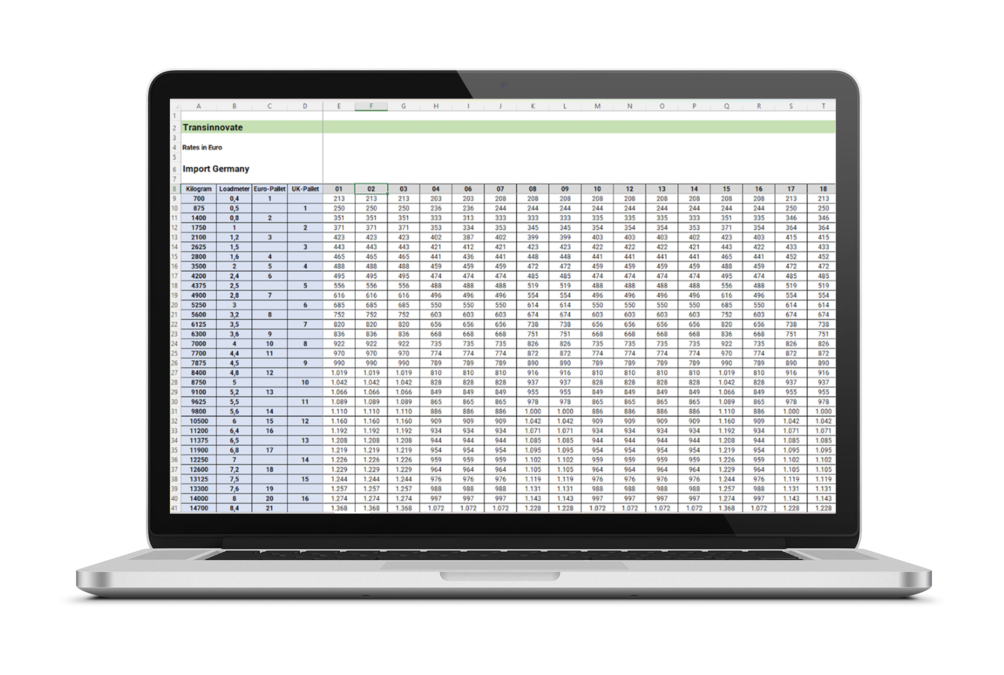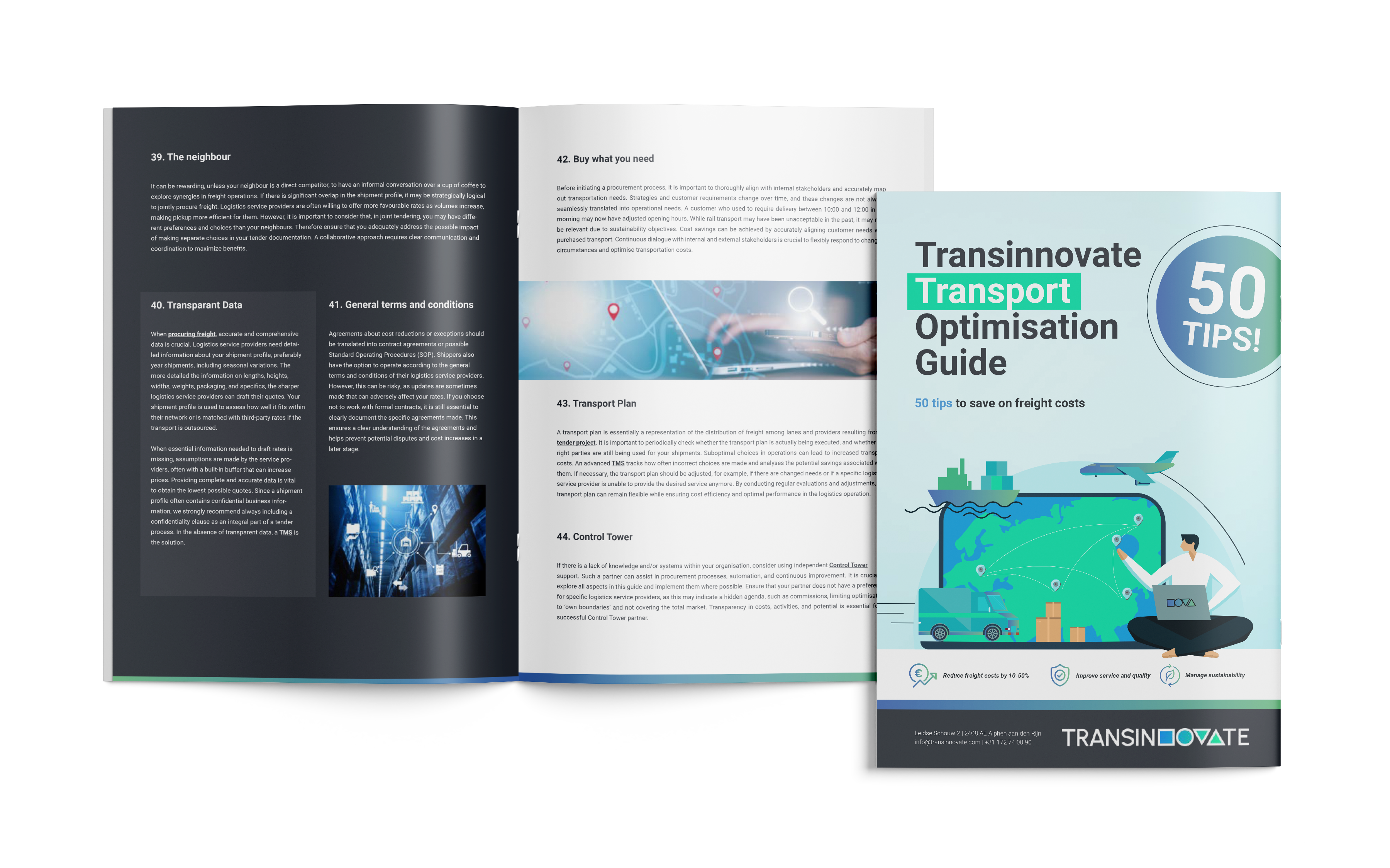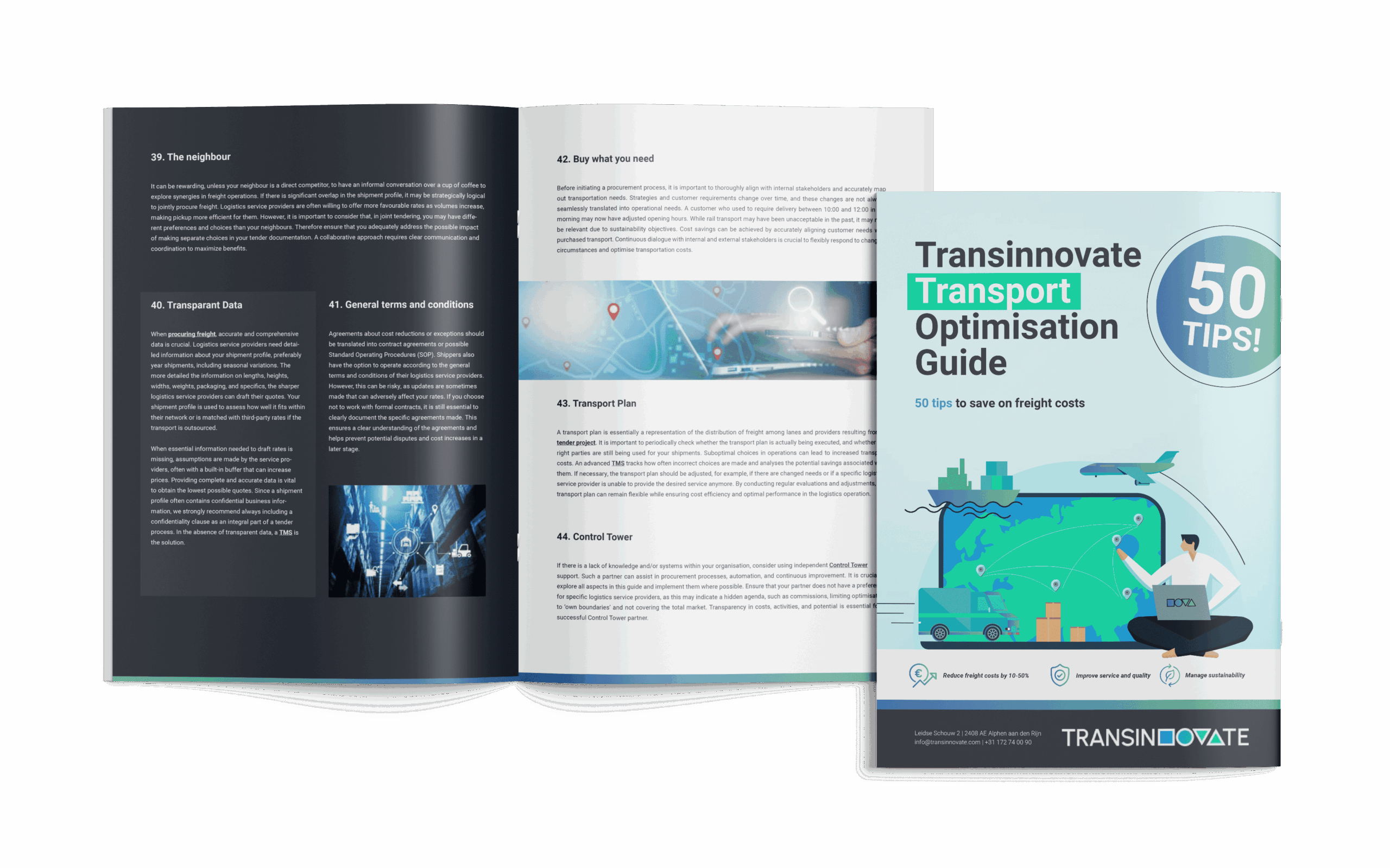
Jeder Verlader, Hersteller oder Händler wünscht sich Logistikdienstleister, die Dienstleistungen anbieten, die sich nahtlos in die eigenen Abläufe und die Erwartungen der Kunden einfügen, aber nicht mehr Kosten verursachen als nötig. Schließlich wirkt sich der Transport direkt auf die Zufriedenheit Ihrer Kunden und Ihre Gewinnspannen und damit auf die Kontinuität Ihres Unternehmens aus. Die Optimierung beginnt bei der Beschaffung. Die Lösung ist die Transportausschreibung.
Die Transportbeschaffung ist eine komplexe und zeitaufwändige Angelegenheit. Jeder Verkehrsträger hat seine eigenen Herausforderungen. Da die Transportbeschaffung kein alltäglicher Prozess ist, verfügen viele Unternehmen über relativ wenig Prozess- und Marktwissen. Außerdem steht oft keine Software für Verkehrsausschreibungen zur Verfügung, um einen guten Einblick zu erhalten. Dabei sind gerade diese Elemente entscheidend für eine effektive Transportbeschaffung.
Der Transport ist für die Kundenzufriedenheit unerlässlich, sollte sich nahtlos in den Geschäftsbetrieb einfügen und die Transportkosten wirken sich direkt auf die Gewinnspanne aus. Unser Beschaffungsprozess zielt auf die Optimierung von Qualität, Service und Kosten ab. Gemeinsam ermitteln wir zunächst, was wirklich benötigt wird. Gute Daten, z. B. aus Ihrem eigenen TMS, helfen dabei.
Wir nutzen auch den Input aus Logistik, Vertrieb, Produktion, Lager, Finanzabteilung und Kundenservice. Dann helfen wir bei der Auswahl der Spediteure. Natürlich unsere derzeitigen Partner, aber auch solche, von denen wir wissen, dass sie mit ihrem Netzwerk und ihren Dienstleistungen perfekt zu uns passen. In dieser Hinsicht sind wir völlig unabhängig. Wir haben keine (Provisions-)Vereinbarungen mit Transportunternehmen und wählen für Sie die besten potenziellen Partner aus.
Eine gute Auswahl gewährleistet eine hohe Rücklaufquote und marktgerechte Angebote. Mit unserer Beschaffungssoftware analysieren wir die Angebote und präsentieren Entscheidungsinformationen. Unsere Software liefert auch detaillierte Rückmeldungen an die beteiligten Spediteure. Schließlich beraten wir Sie, welche Mischung von Spediteuren zu einer guten Abdeckung Ihres Sendungsprofils mit ausreichender Flexibilität und Robustheit führt. Bei Bedarf helfen wir bei der Ausarbeitung von SLAs und Verträgen.


Durch die vielen Ausschreibungen, die wir jährlich durchführen, und unser TMS erhalten wir Einblick in den Markt und die Tarife. Aus einer völlig unabhängigen Position heraus können wir als Exporteure unsere Kunden mit den für sie besten Transportunternehmen in Verbindung bringen.
Ein gutes Verfahren gewährleistet transparente und homogene Angebote, die einen genauen Vergleich sowohl hinsichtlich der Kosten als auch aller wichtigen qualitativen Aspekte ermöglichen. Es gewährleistet eine feste und schnelle Durchlaufzeit.
Gute Werkzeuge sind die halbe Miete, und das gilt auch für die Transportbeschaffung. Die Art und Weise, wie Transporttarife mit unterschiedlichen Tarifen und Zuschlägen angeboten werden, erfordert eine spezielle Software.
Jedes Unternehmen ist anders und ein Beschaffungsprozess muss daher maßgeschneidert sein. Wir bieten maßgeschneiderte Dienstleistungen an, von der vollständigen Entlastung bis hin zur Unterstützung bei Tarifvergleichen zum Beispiel.
Es gibt viele Anbieter von Beschaffungssoftware. Bei der Beschaffung (von Transportmitteln) ist der Kontakt mit den Spediteuren entscheidend. Für uns ist nicht die Software, die wir verwenden, zentral, sondern der Kontakt mit unserem Kunden und den Spediteuren.
Die Kosten für eine Ausschreibung hängen von einer Reihe von Variablen ab, z. B. von der Anzahl der zu bearbeitenden Beförderer und Tariftabellen. Wenn möglich und gewünscht, können wir eine Ausschreibung auf der Basis „no cure no pay“ durchführen.
50 Tipps, wie Sie im Handumdrehen 30 % der Transportkosten sparen können
Möchten Sie mehr über die Optimierung oder das Management von Transporten erfahren? In unserer Transport-Roadmap erfahren Sie mehr!


Antwort innerhalb eines Arbeitstages
Wir zeichnen uns durch Marktkenntnis und Erfahrung in Kombination mit unseren Software-Tools aus.
Unser Ansatz ist vor allem konkret und pragmatisch.

Wir zeichnen uns durch Marktkenntnis und Erfahrung in Verbindung mit unseren Software-Tools aus. Unser Ansatz ist vor allem konkret und pragmatisch. Gerne besprechen wir mit Ihnen Ihre Herausforderungen und erläutern Ihnen unverbindlich, wie wir Sie mit unseren datengestützten Analysen und/oder Softwareanwendungen unterstützen können.
Um Ihnen schnell helfen zu können, haben wir eine Liste mit häufig gestellten Fragen zusammengestellt. Hier finden Sie kurze Antworten auf die am häufigsten gestellten Fragen. Sollten Sie weitere Informationen benötigen, zögern Sie bitte nicht, uns zu kontaktieren.
Oft muss eine Mindestvorlaufzeit von 3 Monaten berücksichtigt werden. Es handelt sich dann um eine Ausschreibung mit 2 Ausschreibungsrunden. Eine gut durchgeführte Ausschreibung erfordert häufig, dass sich die Spediteure ausreichend Zeit nehmen, um sich mit dem Fall zu befassen und Tarife vorzulegen. Auch für die Beschaffung der richtigen Daten für die Beförderung, die Vorbereitung der Ausschreibungs- und Rückmeldungsunterlagen und die Durchführung der Szenarioanalysen sollte ausreichend Zeit eingeplant werden. Infolgedessen dauern große Projekte manchmal etwas länger.
Die Kosten hängen stark von zwei Aspekten ab. Erstens ist die erwartete Leistung wichtig. Wird Ihnen das gesamte Angebot aus der Hand genommen oder nur ein bestimmter Teil des Angebots? Zum anderen spielt der Umfang eine wichtige Rolle. Für wie viele Orte und/oder Länder sollen Tarife angefordert werden, und wie viele Verkehrsunternehmen werden an einer Strecke teilnehmen? Im Allgemeinen sehen wir oft, dass unsere Kunden zwischen 10 und 30 % Einsparungen erzielen, mit Ausreißern bis zu 40 %, und unser Rekord liegt sogar bei 50 %. Auf Wunsch können Sie auch auf Leistungsbasis arbeiten, wobei keine oder weniger Fixkosten anfallen.
Daten sind bei der Organisation von Transportausschreibungen von entscheidender Bedeutung. Je besser Ihre Transportdaten sind, desto gezielter und wettbewerbsfähiger können die Transportunternehmen bieten. Wir raten immer dazu, bei einer Ausschreibung die Daten eines ganzen Jahres mit detaillierten Angaben zu übermitteln. Dies sind Informationen wie z. B. von wo nach wo, Längen, Breiten, Höhen und Gewicht der Sendungen. Wenn möglich, zusätzlich spezielle Informationen wie gewünschte Zuschläge und Besonderheiten. Je besser das Profil in das Netz des Spediteurs passt, desto bessere Tarife werden ausgestellt. Sind die Daten unvollständig, wird der Spediteur vorsichtig sein und daher Puffer in seine Tarife einbauen.
Dies hängt ein wenig von der Branche ab, in der unser Kunde tätig ist, aber im Allgemeinen sind langfristige Partnerschaften zu empfehlen. Um eine gute Partnerschaft zu erreichen, in der die kontinuierliche Verbesserung ein wesentlicher Bestandteil ist, ist es in der Regel ratsam, an einen Partnerschaftszeitraum von 3 bis 5 Jahren zu denken. Nach diesem Zeitraum ist es ratsam zu prüfen, wie sich der Markt entwickelt hat und ob Ihre Tarife noch marktkonform sind.
Dies hängt stark von der Branche ab, in der ein Unternehmen tätig ist, wie ein Sendungsprofil aussieht und welchen Umfang es letztendlich hat. Wenn beispielsweise immer 1-Paletten-Sendungen innerhalb der Niederlande verschickt werden, ist es sinnvoll, eine Reihe von spezialisierten Spediteuren damit zu beauftragen und so die Anzahl der Spediteure zu begrenzen. Bei Transporten aus Europa, von mehreren Ländern in verschiedene Länder und sowohl mit kleinen Sendungen (Sammelgut) als auch mit vollen LKWs (FTL) kann die Anzahl der benötigten Spediteure jedoch bis zu 50 oder sogar 100 betragen. In jedem Fall kann Transinnovate das Sendungsprofil und die gewünschte Dienstleistung bewerten und dann die am besten geeigneten Spediteure auf dem Markt in Bezug auf Kosten und Qualität in Ihre Transportausschreibung aufnehmen.
Kurz gesagt, es geht um Marktkenntnisse, Prozesswissen und einzigartige Software. Viele Unternehmen kaufen Transporte nicht strukturell ein. Folglich bauen sie keine Marktkenntnisse auf, sammeln keine Erfahrungen mit den Do’s and Dont’s von Transportausschreibungen und verfügen nicht über die Software, um komplexe Szenarioanalysen durchzuführen. Darüber hinaus ist eine Transportausschreibung zeitaufwändig, so dass wir die Organisation durch zusätzliche Hände entlasten können.
Wir stellen unseren Kunden detaillierte Entscheidungsinformationen zur Verfügung. Wir berechnen nämlich auf den Euro genau, was die getroffene Wahl kosten wird. Mit unserer Software berechnen wir ein repräsentatives Sendungsprofil (meist jährliche Sendungen) anhand der eingegangenen Angebote. So wird für jede Sendung genau ersichtlich, was sie mit jedem Transportunternehmen kostet. Anschließend analysieren wir gemeinsam mit unseren Kunden Szenarien auf der Grundlage der verfügbaren Kapazitäten, der Nachhaltigkeit, des Service und der Nutzung eines oder mehrerer Frachtführer pro Region, Land oder Gesamtpaket. Das Ergebnis ist eine Analyse, auf deren Grundlage fundierte Entscheidungen getroffen werden können.
Das Feedback ist für die Beförderungsunternehmen von entscheidender Bedeutung, um zu erfahren, wo ihre Angebote verbessert werden können. Der Vorteil ist, dass dies zu besseren Angeboten in jeder nachfolgenden Ausschreibungsrunde führt. In Absprache mit unserem Kunden erstellen wir oft einen Bericht auf Sendungsebene. So kann der Spediteur genau sehen, wo die Stärken und Schwächen seines Angebots liegen. Bei einer Transportausschreibung gibt es immer Gewinner und Verlierer. Es gibt nichts Ärgerlicheres für einen unterlegenen Spediteur, als zu hören: „Tut uns leid, aber wir gehen zu anderen Parteien über“, ohne genau zu wissen warum. Indem Sie also während einer Ausschreibung ein gutes, sauberes und genaues Feedback geben, sorgen Sie dafür, dass auch für abgelehnte Spediteure die Türen offen bleiben. Das ist nützlich, denn Sie könnten sie in Zukunft wieder brauchen.
Das ist möglich, wir helfen Ihnen von der Erstellung der Ausschreibungsunterlagen bis zur Unterstützung im Entscheidungsprozess. Während des Projekts nehmen wir Ihnen sogar die gesamte Kommunikation mit den Spediteuren aus der Hand. Letztlich schließen unsere Kunden die Verträge oder Vereinbarungen mit den zu beauftragenden Transportunternehmen selbst ab. Wir bieten auch Unterstützung bei bestimmten Teilen einer Ausschreibung, zum Beispiel bei der Erstellung komplexer Szenarioanalysen mit unserer Software. Unsere Dienstleistungen sind ganz auf die Bedürfnisse unserer Kunden zugeschnitten.
Fallstricke gibt es viele, aber die beiden größten sind wahrscheinlich, die Kommunikation mit einem Spediteur der Ausschreibungssoftware anzuvertrauen und sich an eine feste Vorlage für Angebote zu halten. Beides geht oft Hand in Hand und kann zu erheblich höheren Transportkosten für Unternehmen führen. Ausschreibungen sind persönlich; Spediteure wollen wissen, wer, was und warum sie sich beteiligen sollen, da eine Ausschreibung auch für sie zeitaufwändig ist. Oft erhalten die Spediteure über die Software nur eine Benachrichtigung, dass sie an einer Ausschreibung teilnehmen dürfen. Infolgedessen entscheiden sich manchmal die für Ihr Profil am besten geeigneten Unternehmen, nicht teilzunehmen – eine verpasste Gelegenheit. Außerdem müssen sie dann ihre Tarife über die Software laden. Warum letzteres absolut problematisch ist, wird in diesem Blog erklärt (https://transinnovate.com/valkuilen-bij-transport-inkopen-the-killing-rate-template/). Es ist also wichtig, einen individuellen Ansatz zu verfolgen und eine Software zu verwenden, mit der die Angebote der Spediteure geladen werden können, wobei es wichtig ist, dass sie weiterhin ihr eigenes Format verwenden können.
Es beginnt mit einer detaillierten Beschreibung der gewünschten Dienstleistung im RFQ-Dokument (Request for Quotation). Berücksichtigen Sie dabei Aspekte wie Anhängertyp, Unternehmenstyp, Öffnungszeiten, Transitzeiten, Serviceniveau und so weiter. Sie können dann ein Konformitätsdokument erstellen, in dem Sie die Spediteure bitten, anzugeben, wie sie diese Aspekte behandeln und ob sie sie erfüllen können. Die Fragen im Compliance-Dokument können möglicherweise in eine Rangfolge gebracht werden, so dass für jeden Spediteur eine Punktzahl ermittelt wird. Es können auch Ausschlusskriterien hinzugefügt werden, um deutlich zu machen, dass es niemals zu einer Zusammenarbeit kommen wird, wenn die Unternehmen diese Aspekte nicht erfüllen können. Letztlich können Sie die Compliance-Scores den Szenario- (Kosten-) Analysen gegenüberstellen und dann im Entscheidungsprozess sowohl kosten- als auch dienstleistungsbasierte Entscheidungen treffen.
Copyright @2025 Transsinovte – Alle Rechte vorbehalten